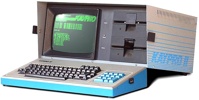Rube's Kickin' it Old-School
Posted by in Tech at 3:36 p.m. on April 02nd, 20060 Comments 0 Pings
At the moment, I’m hard at work transforming a 15-pound paperweight into a healthy, productive workstation. It’s a Sony VAIO PCG-F190 laptop, with a big, fat “Made for Windows 98” sticker on it. Unfortunately, it’s completely incapable of running that operating system, at least if the requisite accessories are running, like firewalls and antivirii.
So now, I’ve got 6 GB of disk space, 640KB of low memory and, God help us, another 63MB of XMS/LIM-EMS distinction to deal with. It’ll be interesting to see if my suppositions are correct, namely that modern computing environments destroy productivity through user-attention overloading.
Basic Setup
Getting the computer up and running was easier than I thought it would be. DOS installation was breeze, as awas Windows for Workgroups 3.11, fine piece of sofware that it is. The only problem I had was getting the PCMCIA network card going. The card itself wasn’t the problem, per se. The problem was getting the PCMCIA subsystem going. Card Services under DOS is handled by software from SystemSoft, which incidentally forbids redistribution and doesn’t offer it themselves. Fuck ‘em, that’s why God made restore CDs from other manufacturers. My real-mode memory management chops were also a little rusty, seeing as I couldn’t get all the hardware drivers loaded along with DOSKEY, MSCDEX, and the rest loaded without sacrificing 50K of low memory
So, let’s take a look at the tools I’ve assembled for the job, out of the distant past, are up to the task.
DOS 6.22
The Cadillac of real-mode operating systems. It contains as much cruft as will actually fit into 640KB of memory, plus or minus a few UMBs. With DOS 6, Microsoft also introduced their very first overtly user-hostile application: MEMMAKER. It was a utility that purportedly harvested unused blocks of upper memory, meaning those bytes between 640K and 1MB, for use by memory-resident programs and drivers. What it actually did was assign addresses in use by network cards and SCSI adapters to SMARTDRV, the disk-cache program, to use as scratch-paper. Hilarity ensued.
WordPerfect 5.1
Now we’re talking pro-duct-ivity, buddy. You can crank out more pages per hour when you can only get 80 characters on a line, you know. And I always thought that kerning was for pussies.
Lotus 1-2-3
Lotus is a gimme. It was the standard that defined what “standard” came to mean in the computer industry: A soulless monopoly that crushes innovation, while fixing prices to the point where buying a software title that amounted to a modern TableView widget for $495.00 actually seemed reasonable. Choice only entered the conversation when deciding whether to pay 500 smackers for the agile 2.2 version, or 500 clams for the flashy 16-vibrant-color VGA-goodness, not to mention ginormous 156MB memory addressing capability of version 3. At UPS, we couldn’t believe our embarrassment of riches, and installed both on all machines.
I’ve been trying out Release 2.2 for a day or so now. It’s a great product, lean and mean, but keeps giving me EMM386 errors. I’ll have to see what I can do about that. It also tends to take a dump when I view a graph in VGA mode. That’s probably the cheesy NeoMagic graphic chip in the VAIO. I’ll set it to CGA and see what happens.
PageMaker
Believe it or not, my first real job was typesetting business cards at a small printing shop in Norcross, Georgia. My workplace consisted of a 20-lb. Kaypro laptop running Windows 2.0, with PageMaker 2.0 (still made by Aldus back then, not Adobe).
(Picture thanks to this awesome site, that also has a picture of Arthur C. Clarke using the exact same computer: Rube have geek boner!)
I did my designs on the 9-inch screen, then I’d ship the PageMaker files to our service bureau, which was all Mac and actually had a laser printer, over a 2400 baud modem. Let me just reiterate my gratitude at this point for the fines folk at Procomm for including ZMODEM in the Test-Drive version of their software. Transfer-resume was an absolute necessity for files over 100K.
Games
Of course, nobody can be productive without a nice set of games to play. At the moment, I’ve got (all from original disks, no less):
Syndicate
Warcraft 1
F-19 Stealth Fighter
That’s it. I’ve got Civilization, Mechwarrior 2, and a few others, but I won’t install them until I’ve found the original disks. Trying to be legal here.
What I’m really looking forward to trying out are the programs that I didn’t get a chance to hit back in the day. So, if anybody’s got a copy of Lotus Improv or dBase III or IV, let me know, and I’ll try to integrate into my new workplace. And I’ll let you know how it went, as soon as I find a 16-bit email program that supports IMAP.

